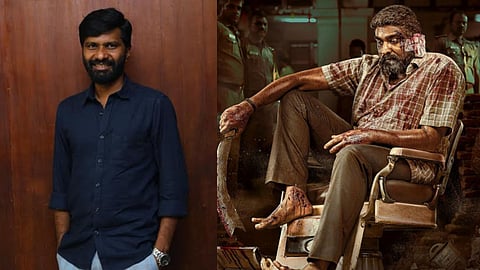

In the blood-filled world of Maharaja, not all pieces of the puzzle are presented to the audience in a straightforward manner. Instead, they are jumbled across multiple timelines and various characters. Editor Philomin Raj, the man behind putting those knots together and unravelling it to the audience, explains that the makers decided upon concealing this nonlinearity from the get-go. “Three timelines start from the moment Maharaja sends his daughter away to the sports camp. The first is fifteen years ago, the second timeline happens seven days before the pivotal incident and then the present one. The director, DOP, and I discussed how to show the period setting of the film. It was decided to keep the setting, costume and props related to the time, but not change the tone of the film. It was shot keeping in mind the current timeline,” he says.
When the footage reached the editing table, Philomin waded through various challenges to make important decisions regarding the story. “We see that Maharaja and his daughter Jothi share a bond with Lakshmi, the garbage bin. It was not there in the beginning and was shot later,” he shares. This also helped them to keep phone conversations between Jothi and Maharaja regarding Lakshmi in order to ‘cheat’ the audience. “Since the audience would know what happened to her if she made a video call, we made the conversation around Lakshmi where Jothi would say that she had called, but Maharaja did not pick up and then enquire if he cleaned and performed pooja for Lakshmi. This would also put pressure on Maharaja as Lakshmi was missing.”
The central characters and their behaviours in Maharaja are also left to the audience to decipher. “Until the first half, there would be a lot of questions in the audience’s mind about the characters. Only in the second half they would get their answers,” he says. This meant that they are left lingering with curiosity and the realisation that Maharaja is not merely fighting for a dustbin but for a serious issue. “For this, we needed a solid flashback. The part where the garage owner sits in the police station with a photo of Dhana (Manikandan), searching for him, was initially in the second half. We felt that this scene, along with the flashback of what happened to him would leave a lasting impression in the first half,” Philomin reveals, adding that they enhanced a few scenes and cut out repetitions after the intermission to make the audience believe that even the daughter was part of Maharaja’s timeline. “I suggested to Nithilan to keep the daughter’s timeline in sync with Maharaja’s final emotional narration. Only when it comes from him, the audience would feel the connection. He agreed to it after I showed it to him.”
Philomin disagrees with the notion that Maharaja has excessive usage of violence. “It is only in two or three places that it gets gory. Even then, those portions were edited after suggestions from the censor board,” he says. In the most crucial scene of all, which involved a minor being subjected to sexual violence, the team ensured that they proceeded with utmost caution. Philomin explains, “The director, DOP and I sat together to make sure we portray the scene as sensitive as possible. Before going for the shoot, it was decided that we would not show sexual violence on screen and there would be no vulgarity in the visual language. It is only their conversation and reactions that we would see. A few dialogues were also added to make Nallasivam more villainous.”
It was also a conscious choice for the makers to not include songs in the film. “You would only see a few lines of the ‘Thaye Thaye’ song. If we included more, it would clash with the tone of the film. Moreover, if we romanticise it, then the audience will predict that Maharaja's daughter will go through something bad in the film,” he notes. Ask him if he faced any pressures since this was Vijay Sethupathi’s 50th film, Philomin says, “I knew Sethu anna before as we worked together in Master. The only thought that I had on my mind was to make sure that a large number of the audience watched this film.”
Up next, Philomin is working on Rajinikanth’s much-anticipated Vettaiyan, directed by TJ Gnanavel and another film with the actor in Lokesh Kanagaraj’s Coolie. “Vettaiyan would be like a mix of both TJ Gnanavel and Rajinikanth's styles. The approach that the director has taken for the film is completely different and is in an investigative drama genre. This film would definitely resonate among the audience well,” he assures.